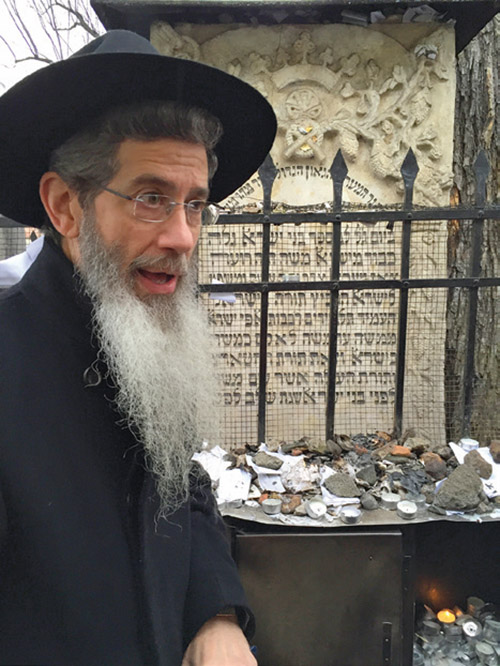

In the final verses of the Torah, Moshe dies under unusual circumstances. We read that God buried Moshe in an unknown location, “and no one knows his burial place to this day.” (34:6) The Gemara (Sotah 13a) elaborates that Moshe’s final resting place was concealed so that his tomb would not become a shrine of pilgrimage for those who deify great leaders of the Jewish people. However, we have to ask ourselves whether this is true. Does not Jewish tradition encourage visiting the gravesites of tzadikim, righteous sages, who have passed away? Think of all those who regularly visit the gravesites of R’ Shimon bar Yochai, or the Lubavitcher Rebbe, or make an annual pilgrimage to Uman on Rosh Hashanah to visit the gravesite of R’ Nachman of Breslov. Why was such a visit to Moshe Rabbeinu’s grave discouraged while visiting the final resting places of these other tzadikim seems to be promoted?
A few years ago I was privileged to join a Project Mesorah tour of Poland. In addition to visiting the remnants of concentration camps, we also visited the gravesites of many tzadikim, righteous men and women who were spiritual leaders of the Jewish people in pre-war Eastern Europe. This tour was led by Ari Scharf and R’ Dovid Goldwassser. We visited many gravesites, including those of the Ramah, the Maggid of Mezritch and R’ Elimelech of Lizhensk, whose yahrzeit was then being observed by thousands of his followers. At these stops, Tehillim would be said and many people prayed for relief of their own personal problems. In fact, I was impressed at the gravesite of R’ Elimelech of Lizhensk where I witnessed men and women crying their hearts out for hours, praying and hoping that their personal prayers would be answered positively.
I also recall that, after completing my smicha (ordination) program in Jerusalem, the yeshiva made a point of having us travel to Tzfat to pray at the graves of R’ Yosef Karo, the author of the Shulchan Aruch and other famous sages. Where did this custom originate and under what circumstances is this appropriate?
The earliest mention of visiting graves is found in the midrash (Sefer HaYashar). When Joseph was taken down to Egypt, he visited his mother’s gravesite on the way. He wept and prayed. Rachel answered him, reassuring him that Hashem would save him from every trial and tribulation. The legend continues that, centuries later, Rachel wept for the Jewish people who passed by her gravesite on their way to exile. Hashem reportedly reassured her that one day her children would return to the holy land.
When Caleb scouted out the future Land of Israel with the other spies, we read that he came to Hevron (Bamidbar 13:22). The Talmud (Sotah 34a) explained that Caleb withdrew from the scheme of the spies and went to pray at the tomb of the Patriarchs, asking that he be saved from their planned evil scheme to disparage the land.
These days, the custom exists to pray and say Tehillim at the graves of tzadikim on Tisha B’Av, before Rosh Hashanah and before Yom Kippur as these are considered auspicious times. The Elef HaMagen is quoted as saying that these prayers are especially beneficial so as to truly achieve repentance and be saved from all material and spiritual troubles that might otherwise ensue.
R’ Abner Weiss explained that there were several compelling reasons to visit the graves of the righteous. First, we show ongoing respect and esteem to those who have passed away. Secondly, we show that these sages have not been forgotten and that we continue to follow their customs and traditions. Third, if they have recently died, we pray for an elevation of their souls in Gan Eden. Lastly, but probably most importantly, we pray to Hashem in their presence, invoking their merit, and transforming our prayer into a prayer that joins the generations.
It is important to bear in mind that our tradition forbids praying directly to the dead. We pray to God in their presence and in their merit. This is in accordance with what we read about Moshe’s death, where it was feared that someone with his stature might end up being the subject of deification.
Historically, we see that this has actually happened in other religions. The supposed messengers of God’s word instead became the object of deification and were made into gods themselves. This happened in Christianity, Islam and Buddhism where Jesus, Mohammed and the Dalai Lama took on god-like qualities and are now prayed to directly.
This gives us greater insight into why Moshe’s burial place is kept secret. We pray in the merit of our righteous tzadikim but do not pray directly to them. May all our prayers be answered for our good and may the coming year bring blessings of peace, health and prosperity to us all.
Rabbi Dr. Avi Kuperberg is a forensic, clinical psychologist in private practice. He is president of the Chai Riders Motorcycle Club of NY/NJ. He leads the Summit Avenue Shabbos Gemara shiur and minyan in Fair Lawn, NJ, and is a member of the International Rabbinical Society. He can be reached at Psychologist@Juno.Com.











